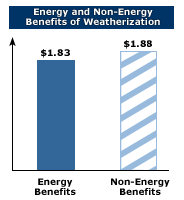 |
January 2003

Each dollar of DOE investment in weatherization returns $3.71 in energy- and non-energy-related benefits. |
There are substantial non-energy benefits from DOE's Weatherization Assistance Program, according to a recent study by Oak Ridge National Laboratory (ORNL). The study documents benefits to utility ratepayers, the economy, and the environment that are in addition to the energy benefits that reduce the energy bills of low-income families by increasing the energy efficiency of their homes.
The U.S. Department of Energy (DOE) issued a press release on August 28, 2002 announcing a report documenting considerable non-energy benefits from low-income weatherization. The report summarizes existing literature on how to value such benefits for participating households, utility ratepayers, the local economy, and the environment. While there is a large range of potential monetary values for these benefits, there is no question they are important for the communities that receive weatherization services.
Furthermore, ORNL's analyses are useful for developing overall cost-benefit ratios. Researchers conclude that for every dollar of DOE investment, there are non-energy benefits worth $1.88.
These benefits are in addition to energy savings, which reduce energy bills an average of $275 per year in more than 105,000 low-income homes in 2002. The cost-benefit ratio of energy reduction is $1.83 for each dollar of DOE investment. When the energy- and non-energy-related benefits are added together, the DOE Weatherization Assistance Program returns $3.71 for every dollar invested by DOE.
Among others, the non-energy benefits of weatherization include:
- For participating households, there are reduced water consumption and accompanying water and sewer fees, and an increase in property values.
- For utility ratepayers, there are reduced costs for bill collection and service shut-offs. And because weatherization addresses the safety of major appliances, the utility has fewer emergency calls.
- For the local economy, DOE's investment in energy efficiency generates a whole range of jobs in local home services industries. Nationwide, the Weatherization Assistance Program generates 8,000 jobs, which increases the tax base in communities throughout the country and indirectly supports other jobs. Furthermore, weatherization reduces the burden of unemployment payments for taxpayers and local businesses.
- For national security, weatherization decreases U.S. energy use the equivalent of 15 million barrels of oil every year.
- For the environment, the reduction in energy consumption by low-income clients reduces the need for combustion of fossil fuels and the resulting emissions into the atmosphere.
The report noted that there are additional benefits from weatherization that are not covered in the study because a monetary value cannot be assigned to them.
Non-Energy Benefits from the Weatherization Assistance Program—A Summary of Findings from Recent Literature (PDF 235 KB). Download Acrobat Reader.
Martin Schweizer and Bruce Tonn; Oak Ridge National Laboratory report number ORNL/CON-484; 41 pp.; April 2002.
Recent Studies and Publications
The Oak Ridge National Laboratory (ORNL) Weatherization and SEP Support Program have published dozens of reports over the past 17 years, many of which are available online. Some hard copies of reports are also available from ORNL.
|

